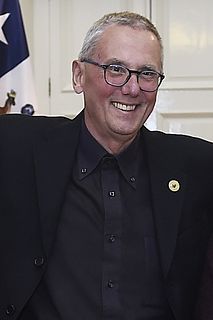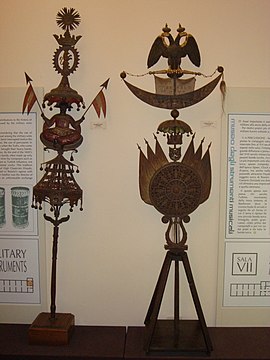
The Accademia Nazionale di Santa Cecilia is one of the oldest musical institutions in the world, founded by the papal bull Ratione congruit, issued by Sixtus V in 1585, which invoked two saints prominent in Western musical history: Gregory the Great, for whom the Gregorian chant is named, and Saint Cecilia, the patron saint of music. Since 2005 it has been headquartered at the Renzo Piano designed Parco della Musica in Rome.
The culture of music in Rome is intensely active. The venues for live music include:
The Orchestra dell'Accademia Nazionale di Santa Cecilia is an Italian symphony orchestra based in Rome. Resident at the Parco della Musica, the orchestra primarily performs its Rome concerts in the Sala Santa Cecilia.

Parco della Musica is a public music complex in Rome, Italy, with three concert halls and an outdoor theater in a park setting. It was designed by Italian architect Renzo Piano. Jürgen Reinhold of Müller-BBM was in charge of acoustics for the halls; Franco Zagari was landscape architect for the outdoor spaces. Parco della Musica lies where the 1960 Summer Olympic Games were held, somewhat north of Rome's ancient center, and is home to most of the facilities of the Accademia Nazionale di Santa Cecilia.
The culture of Rome in Italy refers to the arts, high culture, language, religion, politics, libraries, cuisine, architecture and fashion in Rome, Italy. Rome was supposedly founded in 753 BC and ever since has been the capital of the Roman Empire, one of the main centres of Christianity, the home of the Roman Catholic Church and the seat of the Italian Republic. Due to its historical and social importance, Rome has been nicknamed the Caput Mundi, or "capital of the world".

The National Art Gallery of Bologna is a museum in Bologna, Italy. It is located in the former Saint Ignatius Jesuit novitiate of the city's University district, and inside the same building that houses the Academy of Fine Arts. The museum offers a wide collection of Emilian paintings from the 13th to the 18th century and other fundamental works by artists who were in some way related to the city.
Musical Instrument Museum or Museum of Musical Instruments may refer to:
Filippo Maria Bressan is an Italian conductor.
Lucio Gregoretti is an Italian composer. He composed stage operas, symphonic and chamber music, electro-acoustic music, as well as incidental music for theatre plays, musical comedies, and film scores.

Ennio Porrino was an Italian composer and teacher. Amongst his compositions were orchestral works, an oratorio and several operas and ballets. His best known work is the symphonic poem Sardegna, a tribute to his native Sardinia, which premiered in Florence in 1933.
Mariangela Vacatello is an Italian classical concert pianist from Naples.
Alberto Basso is an Italian musicologist and librarian.

The Conservatorio di Musica Santa Cecilia is a state conservatory in Rome.

Pablo Echaurren is an Italian painter, comics artist and writer.

The Violin Museum is a musical instrument museum located in Cremona. The museum is best known for its collection of stringed instruments that includes violins, violas, cellos and double basses crafted by renowned luthiers, including Antonio Stradivari and Giuseppe Guarneri del Gesù.

The Italian Navy Band is an Italian military band based in Rome which serves under the Italian Navy. The band was established in 1870 in La Spezia and is one of the oldest Italian military band units in the Italian Armed Forces. In 1965, it was transferred to Taranto before it was finally relocated to Rome in 1991. The band conducts concerts both in Italy and abroad, performing for international audiences as well as performing for charity, as is in the case of the concert held in 2004 at the International Center for Peace among the Peoples of Assisi. Common Italian venues the band performs in includes the Milan Auditorium, the Accademia Nazionale di Santa Cecilia, the Parco della Musica, and the Teatro di San Carlo. The band is currently composed of a conductor, a vice conductor, an archivist, as well as 102 NCO musicians drawn from music universities all over the country.
Maria Cecilia Fusco was an Italian operatic soprano and voice teacher. In a long career, she appeared regularly at La Scala in Milan, and leading opera houses in Italy and abroad. Her broad repertoire included works from early Italian opera to premieres of contemporary opera.

Franco Venturini, is an Italian musician based in Paris. From the earliest age he demonstrated an uncommon attitude towards classical music, which led him to pursue a musical career. He started as a pianist, later devoting himself to composition mainly in the fields of contemporary classical music and electronic music.

Auditorium Conciliazione, also known as Auditorio Pio and former Auditorium di Santa Cecilia, is a hall of audiences, concerts and musical performances located at number 4 of the Via della Conciliazione, in the Borgo Rione in Rome, linked to the Palazzo San Pio X. The work of Marcello Piacentini and Giorgio Calza Bini was inaugurated in 1950 and eight years later became the headquarters of the Orchestra dell'Accademia Nazionale di Santa Cecilia until the end of the century.











